Google hires lead Firefox programmer Ben Goodger – Perhaps there might be something to the rumors of a Google browser after all.
Here’s the news from the man himself.
UPDATED
Now Google’s gone and hired yet another Mozilla programmer.
Google hires lead Firefox programmer Ben Goodger – Perhaps there might be something to the rumors of a Google browser after all.
Here’s the news from the man himself.
Now Google’s gone and hired yet another Mozilla programmer.
Friends of Democracy: Iraq Election News – A group of Iraqi bloggers reporting on the election
Announcing the 1st Annual Evangelical Blog Awards – Nominations are open
While my wife and I were visiting my folks in South Florida for Thanksgiving, we spent some time at Everglades National Park. We went to Shark Valley on the northern edge of the park, which gets its name from the Shark River Slough, a broad watery plain, which drains into the Shark River. Water from Lake Okeechobee flows through this area from the north-northeast to the southwest into Florida Bay. The Shark River Slough is commonly called “the river of grass”, for the tall sawgrass marsh which covers the Florida limestone. Shark Valley features a 15 mile loop road, open to hiking and bicycling, and a tram tour of the loop.
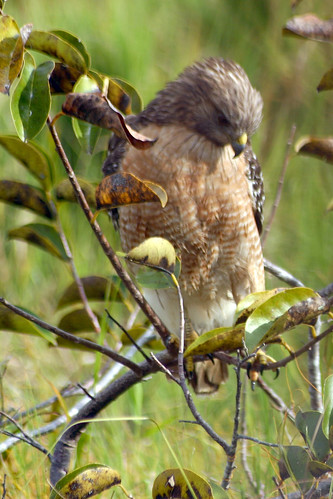
The Red-shouldered Hawk is the most common hawk found in the Everglades.

The Great White Heron is a tropical wading bird related to the Great Blue Heron, and in North America is most often found in South Florida. Great Egrets are found throughout the world. The North American subspecies can be found as far north as Southern Canada. [Note: I originally misidentified this bird. See the comment below.]
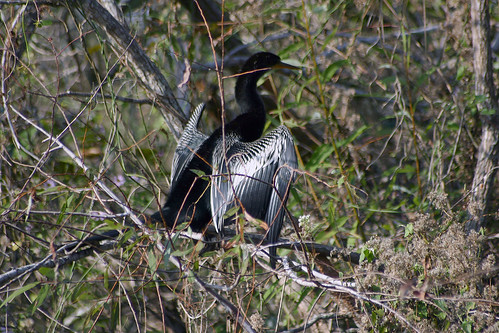
An Anhinga suns itself to dry its wings. It dives underwater to catch fish. This one is male; female Anhingas have a lighter colored neck.
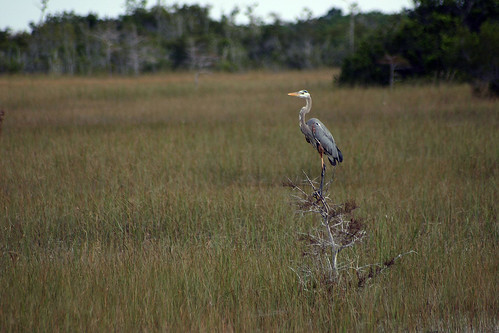
The Great Blue Heron is found throughout the United States. It is a wading bird closely related to the Great White Heron.
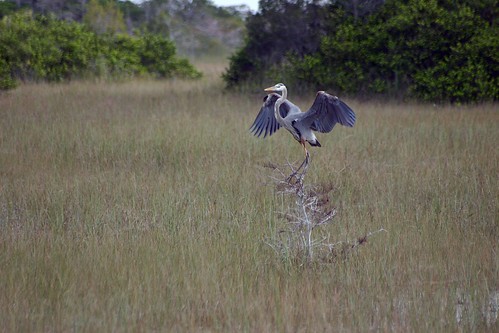
A Great Blue Heron spreads its wings.
Tri-color Herons are a cross breed of the Great Blue and White Herons.
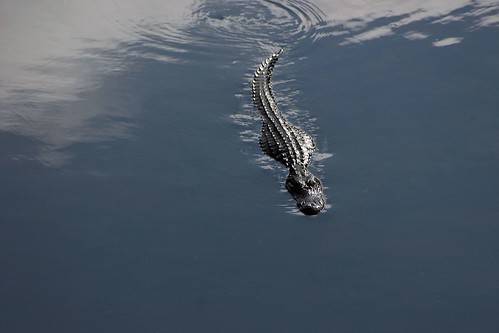
The king of the Everglades: the American Alligator. We watched as this alligator swam gracefully through the water.
The alligator is central to the survival of the Everglades. Alligators dig out pockets in the limestone, known as “Gator holes”. During the dry season which occurs from December through April, these holes become an oasis for many of the park’s insects, turtles, fish, and birds.
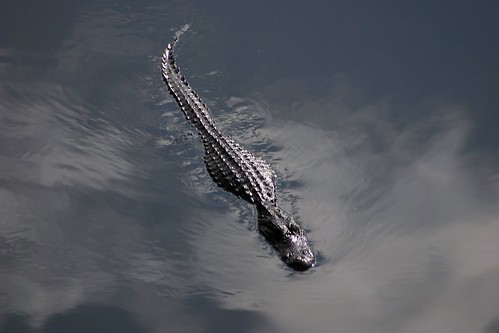
The American Alligator is no longer an endangered species in Florida. They are commonly found in the fresh water sawgrass marshes of the park.
Also, found within the park’s boundaries is the American Crocodile, an endangered species whose only remaining habitat in the United States is the Southern tip of Florida. Everglades National Park is the only place in the world where both alligators and crocodiles exist in close proximity. Crocodiles in the Everglades are located along the coastal areas in the brackish waters of Florida Bay.

The landscape of the Florida Everglades. Taken from atop the viewing tower at the mid-point of the tram tour. The clumps of trees that can be seen in the distance are hardwood hammocks. The hammocks are pockets of limestone rising above the sawgrass prairie which have been built up over time with sediment deposited by the water flowing through Shark River Slough. South Florida is a sub-tropical region, so the hammocks support both tropical trees, such as mahogany, gumbo limbo, and cocoplum, and temperate trees, like live oak, red maple, and hackberry. Many types of orchids and ferns grow under the shade of the tall trees of the hardwood hammock.
Another alligator along the side of the road.
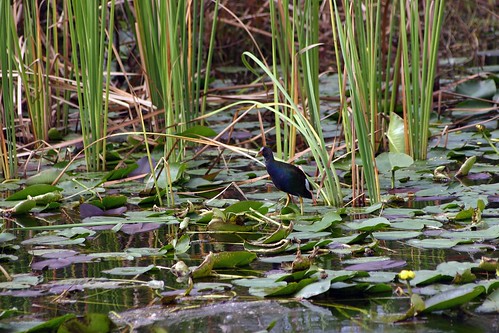
A Purple Gallinule walks upon the spatterdock.
Next, we decided to drive a bit farther down Tamiami Trail to Big Cypress National Preserve Visitor Center. In front of the Visitor Center, the park service has built a viewing platform, which overlooks a stretch of the canal alongside Tamiami Trail. I took the next series of photographs from this vantage point.
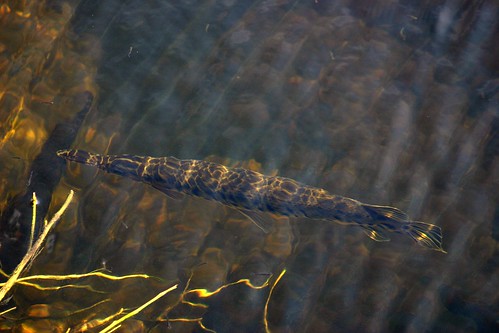
Florida Gar is a freshwater fish found mostly in the lakes, rivers and canals of South Florida.

The body temperature of an alligator is dependent upon the temperature of its environment. To maintain a constant body temperature, alligators will move in and out of the water, sunlight and shade, remaining motionless for long periods of time. This behavior allows an alligator to survive on less food. This can be especially important if the dry season in the Everglades is extended, resulting in fewer food sources. An alligator’s diet includes insects, crabs, crayfish, fish, frogs, snails, turtles, snakes, wading birds, raccoons, otters, deer, and other alligators.
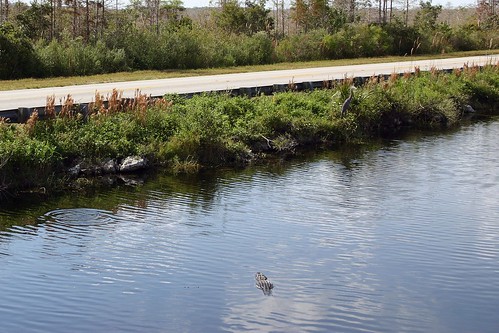
A Great Blue Heron observes as an alligator swims to the opposite bank of the canal.
Idealism and Its Discontents – Victor Davis Hanson examines the neoconservative label
It is commentary like this:
It’s reminiscent of the line from Animal House, when Otter says, “I think that this situation absolutely requires a really futile and stupid gesture be done on somebody’s part.” Bluto answers, “We’re just the guys to do it.” The Democrats have become the party of stupid and useless gestures.
That has put Captain’s Quarters in the realm of higher beings. Congratulations Captain Ed, you deserve it.
Nofollow initiative to combat comment spam – The Google Blog has the details
And he is more gracious than I would be if I were in his place.
The article was, despite Ms Boxer’s kindness, a bad piece of journalism. I had around 45 minutes long phone call with the reporter about my journey with Iraq the Model, my new site, the elections, the general situation here in Baghdad but she (or the paper) seems to have a certain agenda and managed to change the whole issue into a very silly gossip (going as far as quoting trolls!) that is way beneath any respectable paper and certainly beneath me so I won’t give it more attention but lesson learned and I won’t make the mistake of talking to anyone from the NY times again. It’s important to note though that my feelings of respect, gratitude and love for the American people have never and will never change.
Well said, Ali.
Mohammed responds to the article as well.
Yeeeeaaaaaarrrrrgh!!!!!!! – Dean leads DNC race. Via Stephen Green
Text of President Bush’s second inaugural address – Via memeorandum
Money quote:
America’s vital interests and our deepest beliefs are now one. From the day of our Founding, we have proclaimed that every man and woman on this earth has rights, and dignity, and matchless value, because they bear the image of the Maker of Heaven and earth. Across the generations we have proclaimed the imperative of self-government, because no one is fit to be a master, and no one deserves to be a slave. Advancing these ideals is the mission that created our Nation. It is the honorable achievement of our fathers. Now it is the urgent requirement of our nation’s security, and the calling of our time.
And another:
We go forward with complete confidence in the eventual triumph of freedom. Not because history runs on the wheels of inevitability; it is human choices that move events. Not because we consider ourselves a chosen nation; God moves and chooses as He wills. We have confidence because freedom is the permanent hope of mankind, the hunger in dark places, the longing of the soul. When our Founders declared a new order of the ages; when soldiers died in wave upon wave for a union based on liberty; when citizens marched in peaceful outrage under the banner “Freedom Now” - they were acting on an ancient hope that is meant to be fulfilled. History has an ebb and flow of justice, but history also has a visible direction, set by liberty and the Author of Liberty.
When the Declaration of Independence was first read in public and the Liberty Bell was sounded in celebration, a witness said, “It rang as if it meant something.” In our time it means something still. America, in this young century, proclaims liberty throughout all the world, and to all the inhabitants thereof. Renewed in our strength - tested, but not weary - we are ready for the greatest achievements in the history of freedom.